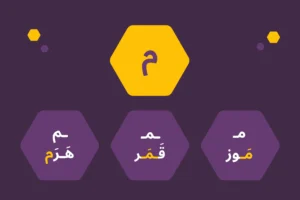
Learn the Arabic Alphabet: The Arabic Letter Meem (م)
Master the Arabic letter Meem (م)! Learn how to pronounce the meem phonetically and its forms. Explore Arabic words and master the Meem in Arabic.
Are you ready to continue our Arabic alphabet journey?
Today, we have a special letter that has no equivalent in English or in any other language, at least not with the same unique throat sound. It is the letter /ʿAyn/ ع.
This is one of the deep letters in Arabic; its sound comes from the middle of the throat and is stronger than the sounds of the light letters.
In this blog, we will examine the various positions this letter can take within words and learn them through examples.
But first, let’s begin with some helpful tips on how to pronounce the letter ع and how to write it.
The letter ع has a unique sound that does not exist in English. It comes from the middle of your throat, and it is voiced, which means your vocal cords vibrate when you say it.
With these steps, you should be getting close. Remember, it’s normal for beginners to find it tricky at first. Keep practicing, and use a mirror if it helps you feel the throat movement.
Tip
Don’t stress if the letter ع feels tricky at first. It’s a sound that doesn’t exist in English, so it takes time for your throat and ear to get used to it. Focus on listening closely and practicing little by little—the clarity will come with patience and repetition.
Let’s look at the shape of the letter ع in its different positions:
Isolated
Initial
Medial
Final
ع
عـ
ـعـ
ـع
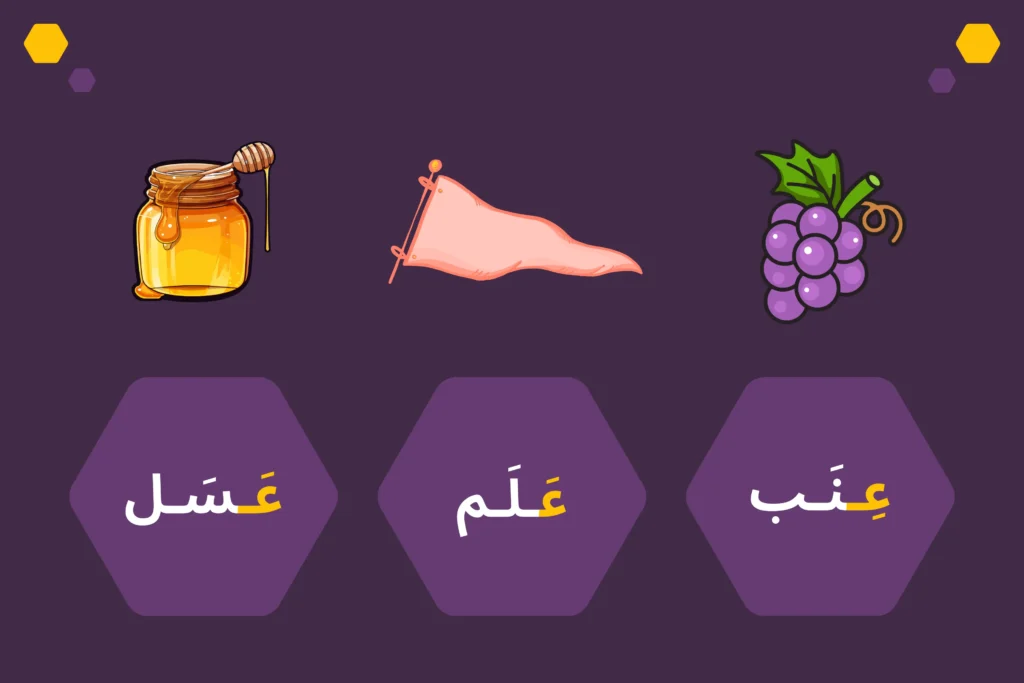
grapes
ʿinab
عِنَب
I ate fresh grapes.
akaltu ʿinaban ṭāzajan
أَكَلْتُ عِنَبًا طَازَجًا
flag
ʿalam
عَــلَــم
The colors of the flag are beautiful.
alwānu al-ʿalami jamīlah
أَلْوَانُ العَلَمِ جَمِيلَةٌ
eye
ʿayn
عَيْن
The eye is the mirror of the heart.
al-ʿaynu mirʾātu al-qalbi
العَيْنُ مِرْآةُ القَلْبِ
honey
ʿasal
عَسَل
I like tea with honey.
uḥibbu ash-shāya maʿa al-ʿasal
أُحِبُّ الشَّايَ مَعَ العَسَل
address
ʿunwān
عُنْوَان
What’s your home address?
mā ʿunwānu baytik?
مَا عُنْوَانُ بَيْتِك؟
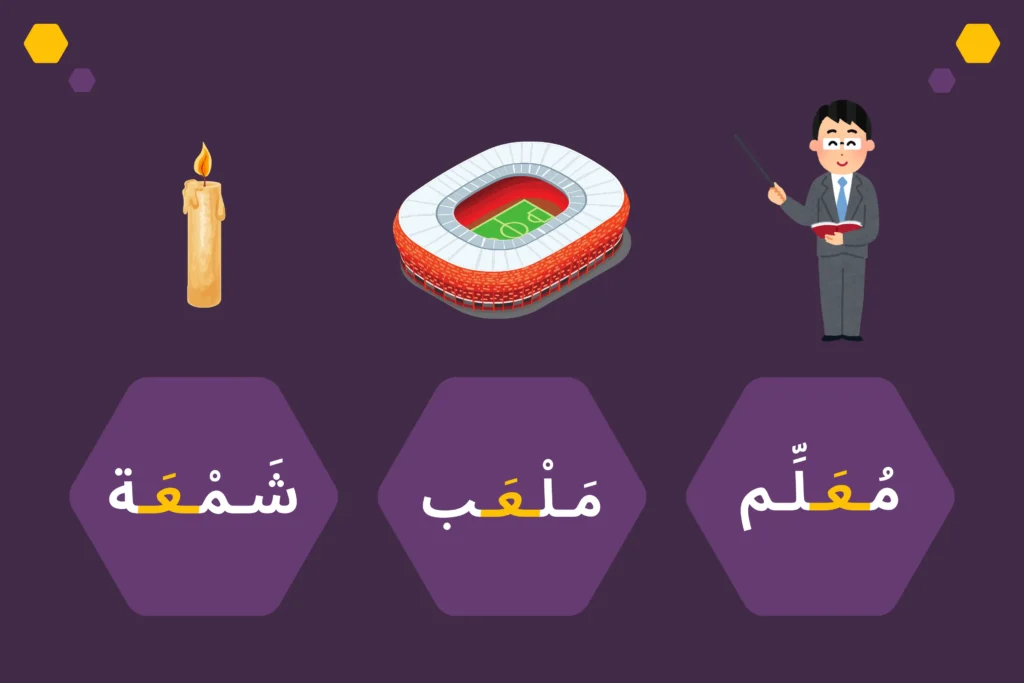
teacher
muʿallim
مُعَلِّم
This is a good teacher.
hādhā muʿallimun jayyid
هٰذَا مُعَلِّمٌ جَيِّد
snake
thuʿbān
ثُعْبَان
I saw a snake in the garden.
raʾaytu thuʿbānan fī al-ḥadīqa
رَأَيْتُ ثُعْبَانًا فِي الحَدِيقَة
playground/stadium
malʿab
مَلْعَب
The children went to the playground.
dhahaba al-aṭfālu ilā al-malʿab
ذَهَبَ الأَطْفَالُ إِلَى المَلْعَب
candle
shamʿa
شَمْعَة
The candle went out quickly.
inṭafaʾati al-shamʿatu sarīʿan
انْطَفَأَتِ الشَّمْعَةُ سَرِيعًا
spoon
milʿaqa
مِلْعَقَة
The child ate with the spoon.
akala al-ṭiflu bil-milʿaqa
أَكَلَ الطِّفْلُ بِالمِلْعَقَةِ
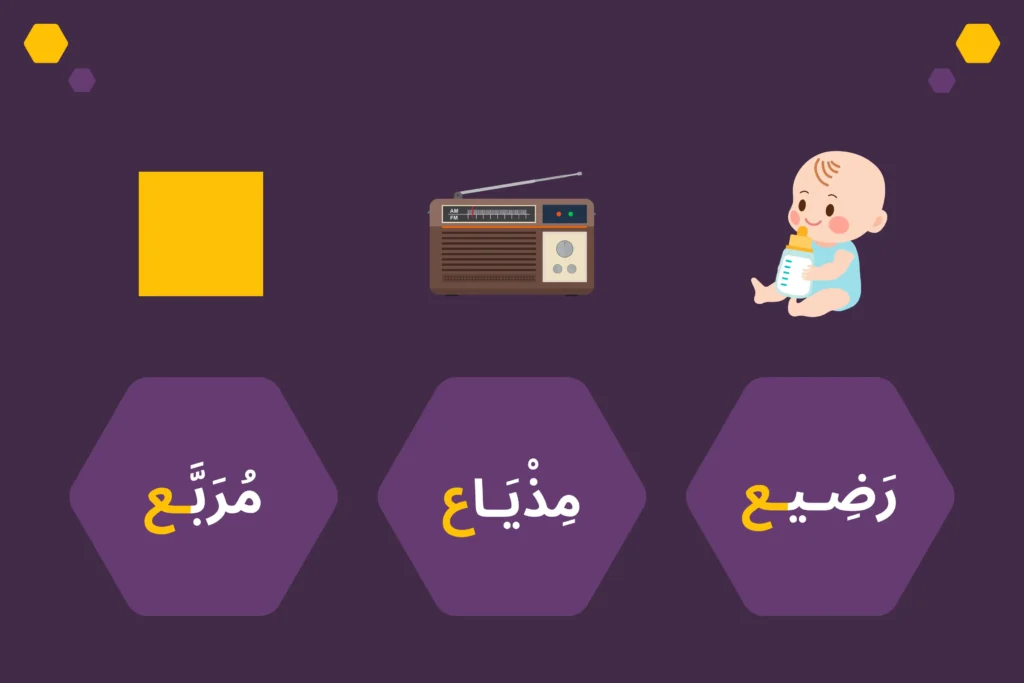
square
murabbaʿ
مُرَبَّع
The boy drew a square.
rasama al-waladu murabbaʿan
رَسَمَ الوَلَدُ مُرَبَّعًا
infant/baby
raḍīʿ
رَضِيع
The baby is in the bed.
al-raḍīʿu fī al-sarīr
الرَّضِيعُ فِي السَّرِير
radio
midhyāʿ
مِذْيَاع
I heard the news on the radio.
samiʿtu al-khabara fī al-midhyāʿ
سَمِعْتُ الخَبَرَ فِي المِذْيَاع
hyena
ḍabʿ
ضَبْع
The hyena is a predator.
al-ḍabʿu ḥayawānun muftaris
الضَّبْعُ حَيَوَانٌ مُفْتَرِس
spring (water source)
nabʿ
نَبْع
We sat by the spring.
jalasnà ʿinda al-nabʿ
جَلَسْنَا عِنْدَ النَّبْع
Now let’s put what you have learned in a quick test. Check the answers below to see hoe many correct answers you got.
Which of the following words starts with the Arabic letter ‘ع’ (ʿAyn)?
A. قَمَر
B. عَين
C. كَلْب
D. بَيْت
What is the English translation of ‘عِنَب’?
A. Apples
B. Grapes
C. Bananas
D. Oranges
Which of these words contains the Arabic letter ‘ع’ (ʿAyn) in the middle?
A. سَمِعَ
B. لعِبَ
C. شَمْس
D. كَاتِب
Which of these words does NOT have the Arabic letter ‘ع’ (ʿAyn) at the end?
A. مَطْبَعَة
B. ضَبْع
C. نَبْع
D. عُصْفُور
You’ve now learned how to write the letter ع, pronounce it correctly, and recognize it in different word positions. Try using the example words in your daily practice of Arabic to master them. And always remember, the more you use them, the easier they’ll become.
You can continue learning the other letters in our Arabic Alphabet Series to gradually expand your skills.
We invite you also to read our article: Arabic Basics for Beginners: 10 Top Essentials to Start Learning. It’s a helpful guide for anyone starting Arabic, with practical steps and resources to build a strong foundation.
You can also download the AlifBee app, which makes learning Arabic fun with games, quizzes, and pronunciation support for every letter. It’s a great tool for keeping your learning structured and enjoyable.


Achieve incredible results with our platform Learn Arabic Online with AlifBee

Join AlifBee Virtual School and master Arabic at your pace — from guided coaching to interactive self-learning.

Learn Arabic faster with live, one-on-one sessions tailored to your level and goals.
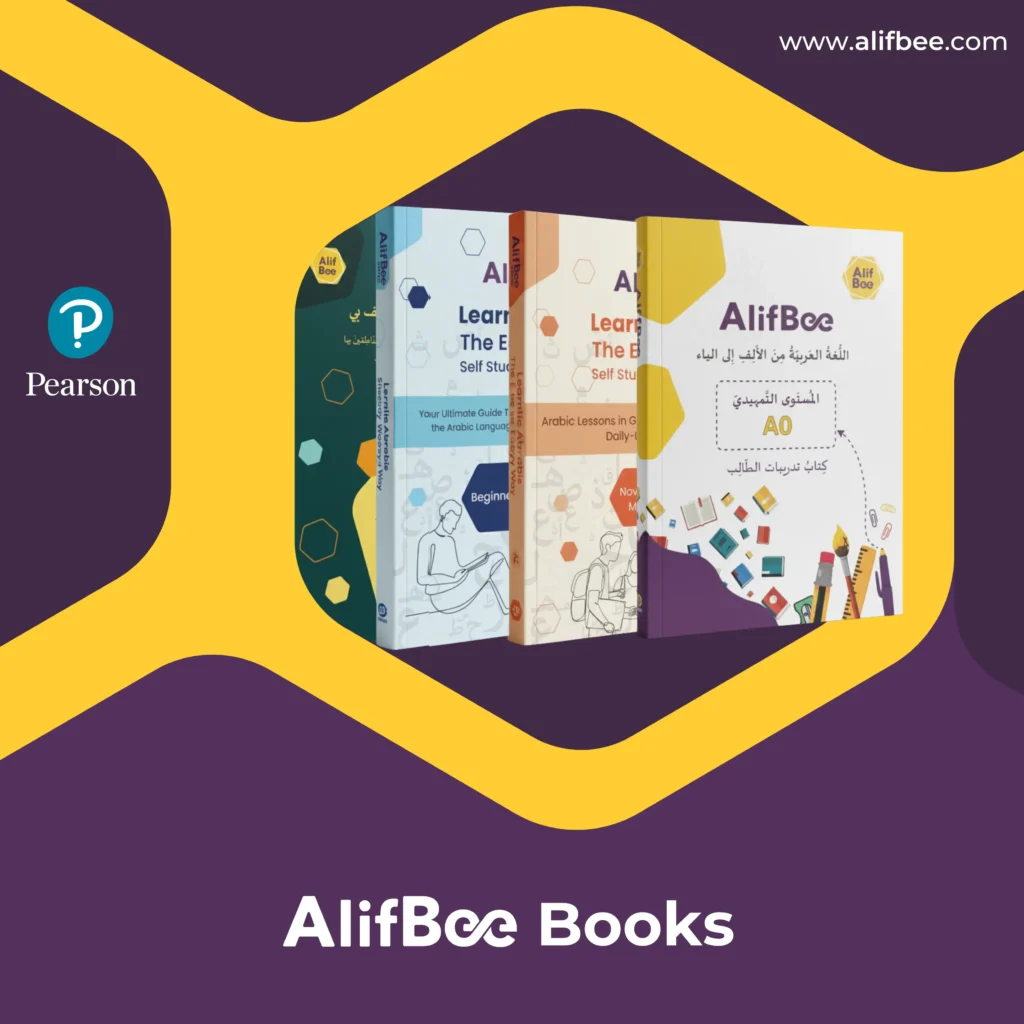
Explore AlifBee’s complete range of Arabic learning books for all ages!

Master the Arabic letter Meem (م)! Learn how to pronounce the meem phonetically and its forms. Explore Arabic words and master the Meem in Arabic.

10 Beautiful Arabic Terms of Endearment: Go beyond “Habibi”! Express your love and affection with these sweet Arabic language terms.

Inspiring collection of motivational quotes in Arabic with pronunciation, English equivalent, and cultural context to help you learn Arabic.

Learn seven ways to say Excuse Me in Arabic to ask someone politely! Learn phrases in Modern Standard Arabic and common dialects.